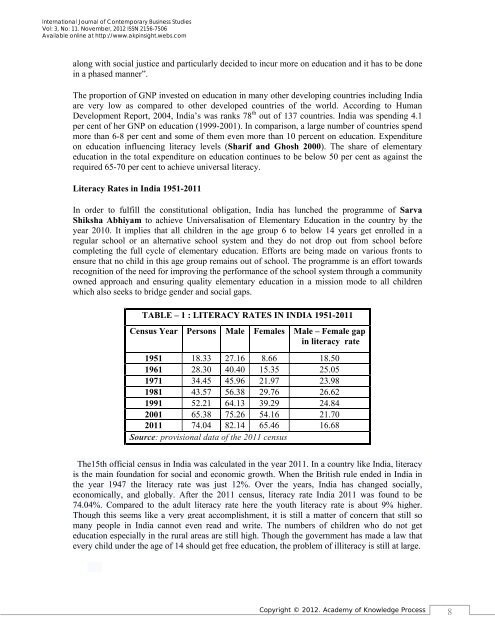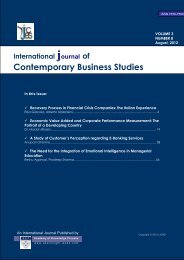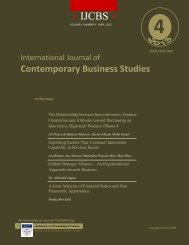International Journal of Contemporary Business Studies
International Journal of Contemporary Business Studies
International Journal of Contemporary Business Studies
Create successful ePaper yourself
Turn your PDF publications into a flip-book with our unique Google optimized e-Paper software.
<strong>International</strong> <strong>Journal</strong> <strong>of</strong> <strong>Contemporary</strong> <strong>Business</strong> <strong>Studies</strong><br />
Vol: 3, No: 11. November, 2012 ISSN 2156-7506<br />
Available online at http://www.akpinsight.webs.com<br />
along with social justice and particularly decided to incur more on education and it has to be done<br />
in a phased manner”.<br />
The proportion <strong>of</strong> GNP invested on education in many other developing countries including India<br />
are very low as compared to other developed countries <strong>of</strong> the world. According to Human<br />
Development Report, 2004, India’s was ranks 78 th out <strong>of</strong> 137 countries. India was spending 4.1<br />
per cent <strong>of</strong> her GNP on education (1999-2001). In comparison, a large number <strong>of</strong> countries spend<br />
more than 6-8 per cent and some <strong>of</strong> them even more than 10 percent on education. Expenditure<br />
on education influencing literacy levels (Sharif and Ghosh 2000). The share <strong>of</strong> elementary<br />
education in the total expenditure on education continues to be below 50 per cent as against the<br />
required 65-70 per cent to achieve universal literacy.<br />
Literacy Rates in India 1951-2011<br />
In order to fulfill the constitutional obligation, India has lunched the programme <strong>of</strong> Sarva<br />
Shiksha Abhiyam to achieve Universalisation <strong>of</strong> Elementary Education in the country by the<br />
year 2010. It implies that all children in the age group 6 to below 14 years get enrolled in a<br />
regular school or an alternative school system and they do not drop out from school before<br />
completing the full cycle <strong>of</strong> elementary education. Efforts are being made on various fronts to<br />
ensure that no child in this age group remains out <strong>of</strong> school. The programme is an effort towards<br />
recognition <strong>of</strong> the need for improving the performance <strong>of</strong> the school system through a community<br />
owned approach and ensuring quality elementary education in a mission mode to all children<br />
which also seeks to bridge gender and social gaps.<br />
TABLE – 1 : LITERACY RATES IN INDIA 1951-2011<br />
Census Year Persons Male Females Male – Female gap<br />
in literacy rate<br />
1951 18.33 27.16 8.66 18.50<br />
1961 28.30 40.40 15.35 25.05<br />
1971 34.45 45.96 21.97 23.98<br />
1981 43.57 56.38 29.76 26.62<br />
1991 52.21 64.13 39.29 24.84<br />
2001 65.38 75.26 54.16 21.70<br />
2011 74.04 82.14 65.46 16.68<br />
Source: provisional data <strong>of</strong> the 2011 census<br />
The15th <strong>of</strong>ficial census in India was calculated in the year 2011. In a country like India, literacy<br />
is the main foundation for social and economic growth. When the British rule ended in India in<br />
the year 1947 the literacy rate was just 12%. Over the years, India has changed socially,<br />
economically, and globally. After the 2011 census, literacy rate India 2011 was found to be<br />
74.04%. Compared to the adult literacy rate here the youth literacy rate is about 9% higher.<br />
Though this seems like a very great accomplishment, it is still a matter <strong>of</strong> concern that still so<br />
many people in India cannot even read and write. The numbers <strong>of</strong> children who do not get<br />
education especially in the rural areas are still high. Though the government has made a law that<br />
every child under the age <strong>of</strong> 14 should get free education, the problem <strong>of</strong> illiteracy is still at large.<br />
Copyright © 2012. Academy <strong>of</strong> Knowledge Process<br />
8

















